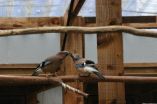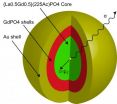(Press-News.org) New research shows that male Eurasian Jays in committed relationships are able to share food with their female partner according to her current desire.
The behaviour suggests the potential for 'state-attribution' in these birds – the ability to recognise and understand the internal life and psychological states of others.
The research was carried out in Professor Nicola Clayton's Comparative Cognition lab at Cambridge University's Department of Psychology, and is published today in the journal PNAS.
Researchers tested mated jays and separated males from females. The females were fed one particular larvae, either wax moth or mealworm – a treat for the birds, like chocolates – allowing the males to observe from an adjacent compartment through a transparent window.
Once the pairs were reintroduced and the option of both larvae was presented, the males would choose to feed their partner the other type of larvae, to which she hadn't previously had access - a change in diet welcomed by the female.
Through different tests using variations on food and visual access to the females during feeding, the researchers show that the males needed to actually see the females eating enough of and become sated by one type of larvae – called 'specific satiety' - to know to offer them the other type once reunited.
This demonstrates that the males' sharing pattern was not a response to their partner's behaviour indicating her preference but a response to the change in her internal state.
"Our results raise the possibility that these birds may be capable of ascribing desire to their mates – acknowledging an 'internal life' in others like that of their own," said Ljerka Ostojic, who led the research.
"Ascribing internal states to other individuals requires the basic understanding that others are distinct from the self and others' internal states are independent from, and differ from, one's own.
When there was no opportunity to feed the female, males chose between the two foods according to their own desires. Only when they could share with the female did they disengage from their own desires and select food the female wanted.
The researchers believe that this ability to respond to another's internal state in a cooperative situation might be important for species living in long-term relationships. Food-sharing is an important courtship behaviour for the Jays – so the ability to determine which food is currently desired by his partner might increase the male's value as a mate.
"A comparison might be a man giving his wife chocolates. The giving and receiving of chocolates is an important 'pair-bonding' ritual – but, a man that makes sure he gives his wife the chocolates she currently really wants will improve his bond with her much more effectively – getting in the good books, and proving himself a better life partner."
INFORMATION:
Monogamous birds read partner's food desires
Research suggests that Eurasian Jays might be able to determine aspects of the 'internal life' of their mate
2013-02-05
ELSE PRESS RELEASES FROM THIS DATE:
Birds may need a hand to weather climate change
2013-02-05
A new study led by Durham University and BirdLife International, shows that many bird species are likely to suffer under future climate change, and will require enhanced protection of important sites, better management of the wider countryside, and in some of the most extreme cases may need to be physically moved to climatically suitable areas to help them survive.
The priority, the researchers say, is for stronger protection and effective management of networks of important sites for conservation which currently support priority species and could offer new habitat for ...
Research suggests meerkat predator-scanning behaviour is altruistic
2013-02-05
VIDEO:
In order to spot potential predators, adult meerkats often climb to a higher vantage point or stand on their hind legs. If a predator is detected, they use several different...
Click here for more information.
In order to spot potential predators, adult meerkats often climb to a higher vantage point or stand on their hind legs. If a predator is detected, they use several different alarm calls to warn the rest of the group. New Cambridge research shows that they are ...
Vitamin C supplements linked to kidney stones
2013-02-05
New research from Karolinska Institutet in Sweden shows that men who take vitamin C supplements regularly run a higher risk of developing kidney stones. The study, which is published in the scientific periodical JAMA Internal Medicine, did not however observe an increased risk between kidney stones and multivitamins – which contain lower concentrations of vitamin C.
The research is based on data from a large population-based study of men from Västmanland and Örebro counties, who were monitored for 11 years. A total of 23,355 men were identified who had no history of ...
Injection-free vaccination technique could address global vaccine challenge for HIV, malaria
2013-02-05
Scientists at King's College London have demonstrated the ability to deliver a dried live vaccine to the skin without a traditional needle, and shown for the first time that this technique is powerful enough to enable specialised immune cells in the skin to kick-start the immunising properties of the vaccine.
Funded by the Bill & Melinda Gates Foundation and published today in Proceedings of the National Academy of Sciences, researchers say although it is an early study this important technical advance offers a potential solution to the challenges of delivering live ...
Chemical reaction keeps stroke-damaged brain from repairing itself
2013-02-05
LA JOLLA, Calif., February 4, 2013 – Nitric oxide, a gaseous molecule produced in the brain, can damage neurons. When the brain produces too much nitric oxide, it contributes to the severity and progression of stroke and neurodegenerative diseases such as Alzheimer's. Researchers at Sanford-Burnham Medical Research Institute recently discovered that nitric oxide not only damages neurons, it also shuts down the brain's repair mechanisms. Their study was published by the Proceedings of the National Academy of Sciences the week of February 4.
"In this study, we've uncovered ...
Biodiversity exploration in the 3-D era
2013-02-05
Taxonomy – the discipline that defines and names groups of organisms – is a field of science that still employs many of the methods used during the beginnings of the discipline in the 18th century. Despite the increasing use of molecular information to delineate new species, the study of the morphology of specimens remains one of the major tasks of taxonomists. These studies often require first-hand examination of the reference specimens (so-called type material) deposited at museum collections around the globe - a time-consuming and laborious task.
To facilitate this ...
New study finds water tubing-related injuries up 250 percent
2013-02-05
Water tubing, a recreational activity in which participants ride an inner tube which is pulled behind a boat by a tow rope, has grown in popularity in recent years. Unfortunately, the number of injuries related to this activity has also increased.
According to a new study by researchers at the Center for Injury Research and Policy of The Research Institute at Nationwide Children's Hospital, the annual number of water tubing-related injuries increased 250 percent over the 19-year study period, rising from 2,068 injuries in 1991 to 7,216 injuries in 2009. Given that more ...
Finding the way to memory
2013-02-05
Our ability to learn and form new memories is fully dependent on the brain's ability to be plastic – that is to change and adapt according to new experiences and environments. A new study from the Montreal Neurological Institute – The Neuro, McGill University, reveals that DCC, the receptor for a crucial protein in the nervous system known as netrin, plays a key role in regulating the plasticity of nerve cell connections in the brain. The absence of DCC leads to the type of memory loss experienced by Dr. Brenda Milner's famous subject HM. Although HM's memory loss resulted ...
February 2013 story tips from Oak Ridge National Laboratory
2013-02-05
HEALTH – Neutron imaging breast cancer . . .
More precise optical imaging is vital for better diagnosis of breast cancer, which strikes one in eight women annually in the United States alone. Researchers at Oak Ridge National Laboratory and the University of Tennessee are using the neutron imaging beam line at ORNL's High Flux Isotope Reactor to evaluate neutron imaging as a powerful new tool for early detection. The study, led by Dr. Maria Cekanova of UT, working with imaging instrument scientist Hassina Bilheux, is using tissue from dogs treated at the UT College of ...
MU scientists build harness for powerful radiation cancer therapy
2013-02-05
VIDEO:
A new discovery might lead to alpha particle therapy for different types of cancer in the near future.
Click here for more information.
COLUMBIA, Mo. ¬— We've all heard that "it's not wise to use a cannon to kill a mosquito." But what if you could focus the cannon's power to concentrate power into a tiny space? In a new study, University of Missouri researchers have demonstrated the ability to harness powerful radioactive particles and direct them toward small cancer ...
LAST 30 PRESS RELEASES:
New study overturns long-held model of how plants coordinate immune responses.
New AI model predicts disease risk while you sleep
Scientists discover molecular ‘reshuffle’ and crack an 80-year-old conundrum
How stressors during pregnancy impact the developing fetal brain
Electrons lag behind the nucleus
From fungi to brain cells: one scientist's winding path reveals how epigenomics shapes neural destiny
Schizophrenia and osteoporosis share 195 genetic loci, highlighting unexpected biological bridges between brain and bone
Schizophrenia-linked genetic variant renders key brain receptor completely unresponsive to both natural and therapeutic compounds
Innovative review reveals overlooked complexity in cellular energy sensor's dual roles in Alzheimer's disease
Autism research reframed: Why heterogeneity is the data, not the noise
Brazil's genetic treasure trove: supercentenarians reveal secrets of extreme human longevity
The (metabolic) cost of life
CFRI special issue call for papers: New Frontiers in Sustainable Finance
HKU Engineering scholar demonstrates the smallest all-printed infrared photodetectors to date
Precision empowerment for brain "eavesdropping": CAS team develops triple-electrode integrated functional electrode for simultaneous monitoring of neural signals and chemical transmitters during sleep
Single-capillary endothelial dysfunction resolved by optoacoustic mesoscopy
HKU three research projects named among ‘Top 10 Innovation & Technology News in Hong Kong 2025’ showcasing excellence in research and technology transfer
NLRSeek: A reannotation-based pipeline for mining missing NLR genes in sequenced genomes
A strand and whole genome duplication–aware collinear gene identification tool
Light storage in light cages: A revolutionary approach to on-chip quantum memories
Point spread function decoupling in computational fluorescence microscopy
BacPhase: Long-insert paired-end sequencing for bin marker construction and genome phasing
GmWOX1 regulates the mediolateral polarity of compound leaves in soybean
ChargeFabrica: An open-source simulation tool that aims to accelerate search for high performance perovskite solar cells
High levels of ADAR overexpression induce abundant and stochastic off-target RNA editing in rice protoplasts
On-demand upgraded recycling of polyethylene and construction of sustainable multifunctional materials based on the "LEGO" strategy
New "Stomata in-sight" system allows scientists to watch plants breathe in real-time
Anorexia nervosa may result in long-term skeletal muscle impairment
Narrative-based performance reviews deemed fairest by employees
New insights reveal how advanced oxidation can tackle emerging water pollutants
[Press-News.org] Monogamous birds read partner's food desiresResearch suggests that Eurasian Jays might be able to determine aspects of the 'internal life' of their mate




